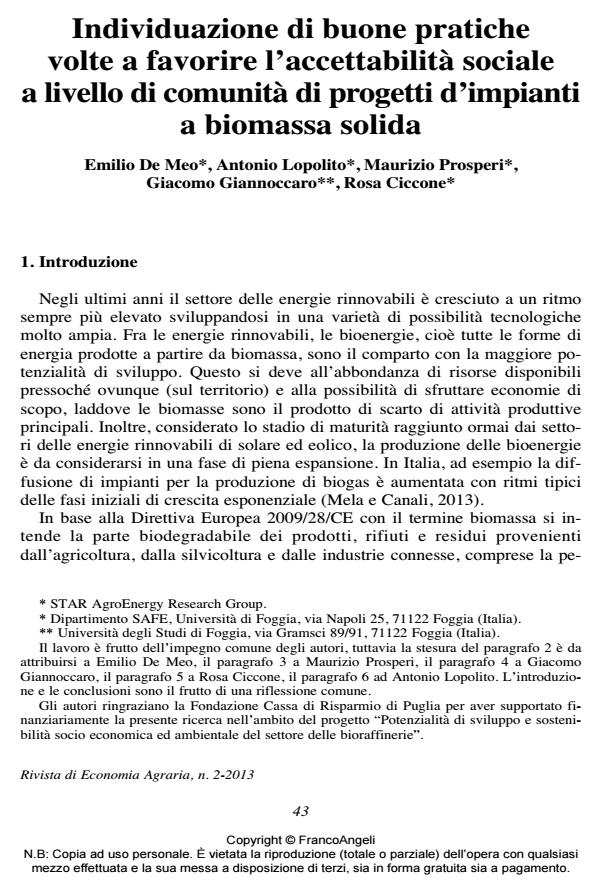Identification of good practices aimed at favouring acceptance of solid biomass plants by the local community
Journal title RIVISTA DI ECONOMIA AGRARIA
Author/s Emilio De Meo, Antonio Lopolito, Maurizio Prosperi, Giacomo Giannoccaro, Rosa Anna Ciccone
Publishing Year 2014 Issue 2013/2
Language Italian Pages 20 P. 43-62 File size 703 KB
DOI 10.3280/REA2013-002003
DOI is like a bar code for intellectual property: to have more infomation
click here
Below, you can see the article first page
If you want to buy this article in PDF format, you can do it, following the instructions to buy download credits

FrancoAngeli is member of Publishers International Linking Association, Inc (PILA), a not-for-profit association which run the CrossRef service enabling links to and from online scholarly content.
The siting of solid biomass energy plants can be conceived as a transaction process taking place between two specific economic agents, the investor and local community. The investor is interested in obtaining the use right for local resources (e.g. area for setting; natural resources to feed the process, release of pollutants in the environment) while the community expects an increase of net benefits (es. job opportunities, induced industrial development, revitalization of the local economy). This transaction process has been analyzed according to the typical transaction costs theory, where the economic activities are conceived as the result of transactions among economic agents, which are hindered by three main obstacles: a) bounded rationality, b) opportunism, c) asset specificity. By applying the New Institutional theory approach, we treat the issue of social acceptance as a transaction cost problem. The aim is to identify the best practices adopted by biomass firms managers in order to enhance the social acceptance of solid biomass plants at local community level. In this paper we conduct a positive analysis where the methodological approach is based on the comparison of five case successful study cases. This allowed us to identify thirteen measures, capable to foster the social acceptance, and consequently to reduce the costs related to the investment.
La localizzazione degli impianti energetici alimentati a biomassa solida può essere concepita come un processo di transazione in corso tra due agenti economici specifici: l’investitore e la comunità locale. L’investitore è interessato ad ottenere il diritto all’utilizzo di risorse locali (ad esempio, un’area per l’installazione della centrale, le risorse naturali per alimentare il processo, il rilascio di sostanze inquinanti nell’ambiente) mentre la comunità si aspetta un incremento di benefici netti (es. opportunità di lavoro, sviluppo dell’indotto industriale, rivitalizzazione dell’economia locale). Questo processo di transazione è stato analizzato secondo la tipica Teoria dei Costi di Transazione, in base alla quale le attività economiche sono concepite come il risultato di transazioni tra agenti economici, che sono ostacolate da tre barriere principali: a) razionalità limitata, b) opportunismo, c) specificità delle risorse. Applicando l’approccio della Nuova Economia Istituzionale, in questo lavoro il problema dell’accettabilità sociale è inquadrato come un problema attinente i costi di transazione. L’obiettivo è quello di individuare le migliori pratiche, adottate dai gestori degli impianti a biomassa, al fine di migliorare l’accettabilità sociale di tali impianti a livello delle comunità locali. In questo lavoro si è proceduto ad un’analisi positiva dove l’approccio metodologico si basa sul confronto di cinque casi studio di successo. Questo ha permesso di identificare le tredici misure in grado di favorire l’accettabilità sociale e quindi di ridurre i costi relativi all’investimento.
Keywords: Best practices, social acceptance, biomass plants, transaction costs
Jel codes: Q42, Q52
Emilio De Meo, Antonio Lopolito, Maurizio Prosperi, Giacomo Giannoccaro, Rosa Anna Ciccone, Individuazione di buone pratiche volte a favorire l’accettabilità sociale a livello di comunità di progetti d’impianti a biomassa solida in "RIVISTA DI ECONOMIA AGRARIA" 2/2013, pp 43-62, DOI: 10.3280/REA2013-002003